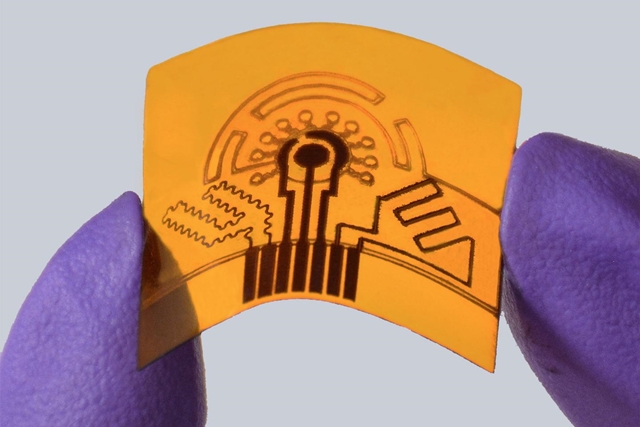26 Nov. 2019. A thin-film wearable sensor is shown in tests with volunteers to measure the presence of acids indicating gout in the chemistry of a person’s sweat. A team from California Institute of Technology in Pasadena, describes the device and its findings in yesterday’s issue of the journal Nature Biotechnology (paid subscription required).
Researchers led by CalTech medical engineering professor Wei Gao are seeking simpler and non-invasive methods to monitor a person’s vital signs and detect for indicators of disease, particularly in low quantities or concentrations. Many current tests for biomarkers, protein indicators of a person’s health, require larger quantities that up to now use more invasive methods, such as blood samples.
Gao and colleagues developed a device with a sensor engraved into a thin plastic film worn on the skin. The sensor is made with graphene, a light, strong, and chemically stable carbon material that conducts both heat and electricity. The researchers fabricated the device with carbon dioxide laser engraving, a simpler and less expensive process than conventional lithography and evaporation.
Using this process, the team designed a device with microfluidics, or ultra-thin channels that absorb a person’s sweat. The minute quantities of sweat taken into the channels are enough for the graphene sensors in the device to measure several health indicators. The CalTech team and colleagues at other institutions in the U.S. and China, demonstrated with volunteer subjects that their prototype sensor device could measure body temperature and respiratory rate from sweat samples.
To further prove the concept, the researchers designed the sensor to detect and measure the presence of compounds in sweat indicating possible health issues. One of those compounds is uric acid, an indicator of gout, a complex form of arthritis. Gout is marked by sudden and severe episodes of pain, with tenderness and redness in the joints, and occurs when uric acid builds up and forms needle-like crystals in the joints or surrounding tissue, causing pain and inflammation. Another compound tested was tyrosine, an amino acid associated with metabolic disorders, liver disease, and neurological conditions.
To test the device for changes in uric acid, the researchers asked volunteers to eat a diet high in purines, substances that the body converts to uric acid, and in excess can can contribute to gout. The sensors showed uric acid levels rising among the volunteers after the purine-rich meal. The team also asked people with gout to wear the sensor, and found the patients have higher uric acid levels than people without the disorder. Blood tests for uric acid later verified those findings.
To test for tyrosine levels, a substance affected by a person’s physical fitness, the researchers asked trained athletes to wear the sensor devices and compared the findings with healthy, but non-athlete volunteers. The results showed, as expected, the devices worn by trained athletes measure lower tyrosine levels in their sweat than normal individuals.
“Such wearable sweat sensors have the potential to rapidly, continuously, and non-invasively capture changes in health at molecular levels,” says Gao in a CalTech statement. “They could enable personalized monitoring, early diagnosis, and timely intervention.” The team anticipates these devices could enable continuous monitoring of people with complex disorders like gout, as well as diabetes and cardiovascular diseases that today require either more elaborate equipment or visits to a clinic.
More from Science & Enterprise:
- Infographic – Big Wearables Spending Growth Expected
- Digital Meds Boost Hepatitis C Drug Adherence
- Graphene Material Designed for Wearable Devices
- Implanted Overdose Rescue Device Being Developed
- Peanut Allergy Patch Under FDA Review
* * *


 RSS - Posts
RSS - Posts
[…] Wearable Sensor Analyzes Sweat, Measures Chemicals […]